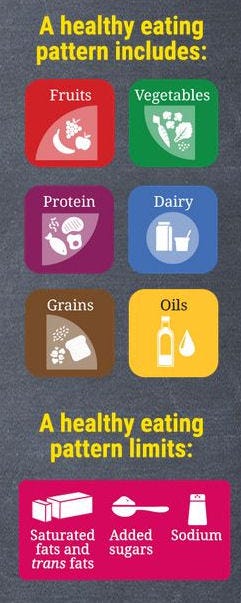Stamp of approval for lean meats and removing upper limits for cholesterol intake on eggs are wins for ag industry.

The U.S. Department of Agriculture and the U.S. Department of Health & Human Services released updated nutritional guidelines Jan. 7 that encourage Americans to adopt a series of science-based recommendations to improve how they eat to reduce obesity and prevent chronic diseases like type 2 diabetes, hypertension and heart disease.
Updated every five years, this report serves as the foundation for federal nutrition policy and shapes the recommendations found on USDA’s MyPlate.

Over the past year, the dietary guidelines created concerns when the draft report looked like it would incorporate sustainability into food considerations and would no longer consider lean meat as part of a “healthful diet.”
In the end, the final recommendations reaffirmed the role of lean beef in a healthy diet and confirmed that Americans are, on average, consuming lean meat in daily amounts that are consistent with the recommendations for protein foods.
HHS and USDA noted that the eighth edition of the "Dietary Guidelines for Americans" reflects advancements in scientific understanding about healthy eating choices and health outcomes over a lifetime. “This edition recognizes the importance of focusing not on individual nutrients or foods in isolation but on the variety of what people eat and drink — healthy eating patterns as a whole — to bring about lasting improvements in individual and population health,” HHS and USDA said in a joint statement.
"The latest edition of the dietary guidelines provides individuals with the flexibility to make healthy food choices that are right for them and their families and take advantage of the diversity of products available, thanks to America's farmers and ranchers," Agriculture Secretary Tom Vilsack said.
The specific recommendations fit into five overarching guidelines in the new edition:
1. Follow a healthy eating pattern across one's life span. Eating patterns are the combination of foods and drinks a person consumes over time.
2. Focus on variety, nutrient-dense foods and amount.
3. Limit calories from added sugars and saturated fats, and reduce sodium intake.
4. Shift to healthier food and beverage choices.
5. Support healthy eating patterns for all.
The North American Meat Institute (NAMI) praised the government’s affirmation of meat and poultry nutrition. “Meat and poultry products are among the most nutrient-dense foods available. They are rich sources of complete protein, iron, zinc and B vitamins, and many peer-reviewed studies show the contributions they make to healthy diets and the potential deficiencies that can occur when people exclude animal proteins,” NAMI president and chief executive officer Barry Carpenter said. “The dietary guidelines confirm that a variety of dietary patterns can be followed to achieve a healthy eating pattern. Consumers who choose to eat meat and poultry, as 95% of Americans do, can continue to enjoy our products as they have in the past.”
The National Cattlemen’s Beef Assn. also welcomed the inclusion of lean beef. Thirty-eight cuts of beef now meet government guidelines for "lean," including some of America’s favorite cuts, like sirloin steak and 95%-lean ground beef.
“Lean beef is a wholesome, nutrient-rich food that helps us get back to the basics of healthy eating, providing many essential nutrients such as zinc, iron, protein and B vitamins, with fewer calories than many plant-based sources of protein,” said Dr. Richard Thorpe, a physician and Texas cattle producer. “Numerous studies have shown positive benefits of lean beef in the diet, and I commonly encourage my patients to include beef in their diet to help them maintain a healthy weight and get the nutrients they need to be physically active.”
The dietary guidelines also remove a daily limit on dietary cholesterol and include eggs in all three recommended healthy eating patterns: the Healthy U.S.-style, the Healthy Mediterranean-style and the Healthy Vegetarian-style. This generated praise from the American Egg Board and Egg Nutrition Center.
"The U.S. has joined many other countries and expert groups like the American Heart Assn. and the American College of Cardiology that do not have an upper limit for cholesterol intake in their dietary guidelines," said Dr. Mitch Kanter, executive director of the Egg Nutrition Center.
One egg has varying amounts of 13 essential vitamins and minerals, high-quality protein and the antioxidants lutein and zeaxanthin — all for 70 calories. Eggs are also one of the few foods that are naturally a good source of vitamin D, which was identified by the 2015 Dietary Guidelines Advisory Committee as a nutrient of concern for under-consumption and necessary for helping build strong bones.
Healthy eating patterns also allow fat-free or low-fat dairy, including milk, yogurt, cheese and/or fortified soy beverages. A variety of protein foods, including seafood, lean meats and poultry, eggs, legumes (beans and peas), soy products and nuts and seeds, also are included in a healthy eating pattern.
The DGA notes that current intakes of dairy foods for most Americans “are far below recommendations of the Healthy U.S.-Style Pattern,” and they call for a shift to consume more dairy products. A joint statement from dairy groups noted that because of dairy foods’ nutrient-rich package, it can be challenging for most Americans, mainly those aged nine and older, to meet nutrient recommendations without eating three servings of dairy a day. “When foods from the dairy group are removed from daily eating patterns, or replaced with sugar-sweetened beverages, calcium, iron, magnesium, vitamin A and riboflavin dropped below 100% of goals. What’s more, levels of vitamin D and potassium, as well as choline, dropped substantially,” the groups said.
Healthy eating patterns limit saturated and trans fats. The guidelines suggest that less than 10% of daily calories should come from saturated fats. Foods high in saturated fat include butter, whole milk, meats that are not labeled as lean and tropical oils such as coconut and palm oil. Saturated fats should be replaced with unsaturated fats, such as canola or olive oil, the report notes.
About the Author(s)
You May Also Like




.png?width=300&auto=webp&quality=80&disable=upscale)
